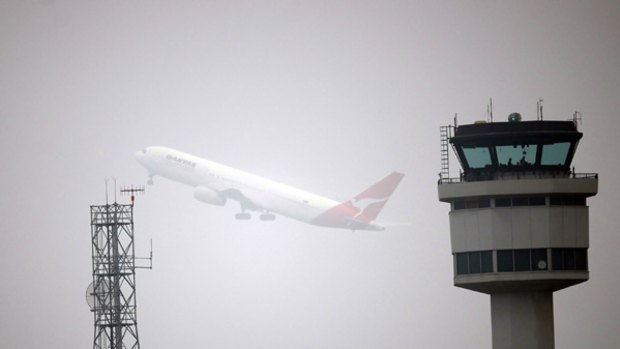
Foul weather ... airlines are adding more time to their schedules to compensate.Credit: Joe Armao
Storm and tempest are largely to blame for more late flights, writes Clive Dorman.
It's a long-standing truism that the reason for Australia's near-flawless air travel safety record is that it "doesn't have weather", while the US and Europe face frequent blizzards, hurricanes and severe electrical storms.
But now Australia truly does "have weather" - and lots of it. In the past two years, increasing incidences of fog, wind and rain have been blamed for an otherwise mysterious deterioration in the punctuality of Australia's air services. Once the best in the world, they are now comparable with the chronic delay-ridden industries of Europe and the US.
Ernst Krolke , the chief executive of Airport Co-ordination Australia, which controls the allocation of take-off and landing "slots" at Australia's main airports, says creeping congestion and air traffic control problems have played a part in delaying an increasing number of flights around the country.
"It's a very intriguing problem," he says. "On-time performance has been deteriorating for a couple of years. But I have to say the main reason has been the weather."
In the past year, fog has partially or temporarily shut the main airports in Melbourne and Sydney. High winds have particularly affected Sydney Airport, the fulcrum of the entire national system. Heavy rain has also slowed the airport's ability to process take-offs and landings.
In November, only 75.9 per cent of flights around the country arrived on time.
In November, only 75.9 per cent of flights around the country arrived on time, compared with more than 86 per cent in the middle of this decade.
There was also an abnormally high rate of flight cancellations: 2.1 per cent nationally.
There was little difference between the main airlines (Tiger 78.6 per cent, Jetstar 78.4 per cent, Qantas 78.2 per cent) - except for Virgin Blue, which used to boast about its leadership in the on-time stakes. In November, it got only 73.2 per cent of its flights to their destinations on time.
A recurring theme was that the two biggest airports, Melbourne (73.6 per cent) and Sydney (73.3 per cent), had some of the worst on-time arrival figures among the capital cities. Brisbane (81.1 per cent) was the best. Perth (63.5 per cent) was the worst - but that's unavoidable because of the unpredictability of westerly headwinds across the Nullarbor.
On the east coast, the airlines are adding more and more minutes to their scheduled flying times to artificially turn late flights into "on-time" flights. Jetstar, for example, says it takes one hour and 35 minutes to fly from Sydney to Melbourne's Avalon airport, which means the flight won't be declared late until it takes longer than one hour and 50 minutes, since the on-time figures include a 15-minute allowance.
The actual flying time is about 65 minutes.
Jetstar, for one, says its on-time performance has improved since November. The airline is relying increasingly on the use of self-check-in airport kiosks and web check-in to get aircraft turned around faster, says spokesman Simon Westaway, while also flying each aircraft for more hours every day to increase efficiencies.
That balancing act - along with the vagaries of the weather - makes it "a real chess game to make sure you don't checkmate yourself", he says.
Sign up for the Traveller Deals newsletter
Get exclusive travel deals delivered straight to your inbox. Sign up now.